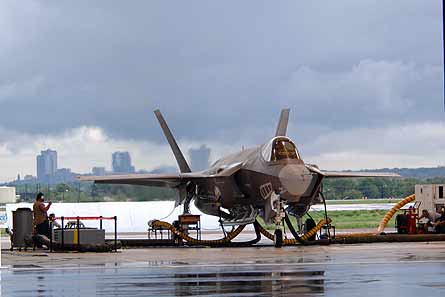Lockheed Martin is preparing to fly the F-35 Joint Strike Fighter (JSF) for the first time next week (pictured below).
A flight readiness review was planned for today following analysis of some small data “anomalies” observed during engine runs on Wednesday.
If given the go-ahead, Lockheed will begin low-speed and high-speed taxi tests at the Fort Worth, Texas plant, after which the engine will undergo a boroscope inspection, says JSF deputy programme executive officer Brig Gen David Heinz.
|
|---|
He plays down the anomalies detected during engine runs. “We are sampling nine different databus on this airframe, and seeing into things we have never seen into before and the engineers saw bit changes they didn’t expect,” he says.
“There is a lot of conservatism, but there are also certain acceptable risks. I am confident we will fly next week,” Heinz says. Lockheed has been aiming for an 11 December first flight, but the weather forecast makes this unlikely, he says.
The F-35’s maiden flight will be the first by an all-new US fighter since the Lockheed/Boeing F-22 took to the air on 7 September 1997, and will come just over five years after the company won the JSF competition. Its X-35 concept demonstrator aircraft first flew on 24 October 2000.
The first JSF development aircraft to fly, AA-1, is a conventional take-off and landing (CTOL) variant, but is not structurally representative of production F-35s because of later design changes introduced to reduce the weight of the short take-off and landing (STOVL) variant.
Heinz says a 60min first flight is planned, flown by Lockheed ‘s JSF chief test pilot John Beesley, during which the aircraft will be flown first to 11º angle of attack and then to 14º to clear the approach and landing envelope. “We will fly to 25,000ft and cycle the gear,” he says.
The Co-operative Avionics Test Bed, or CATBird, a modified Boeing 737-300 that will be used to flight test the JSF mission-system avionics and software blocks before they fly in the F-35, is expected to fly a week later, says Heinz.
The aircraft has been modified by JSF partner BAE Systems at its Mojave, California site, with addition of the F-35’s forebody on the nose, a geometrically representative “wing” mounted on the forward fuselage in which sensors will be located, and an F-35 cockpit and engineering stations installed inside. The CATBird will be flown to Fort Worth for installation of the sensors and other systems.
The next JSF development aircraft, the first “optimised-airframe” STOVL F-35B, is now due to fly in the second quarter of 2008, says Heinz. The first flight was delayed by the weight-reduction redesign and subsequent problems encountered in machining a new fuselage bulkhead introduced as part of the redesign.
Internationally, the JSF programme office expects all eight partner nations – with the possible exception of Norway - to sign the memorandum of understanding on the production, sustainment and follow-on development phase by the end of the year.
Norway could slip into next year because of “staffing issues”, Heinz says. The Netherlands has already signed, and Canada and Australian are expected to sign next week, he says. Negotiations are in the final stages with the other partners: Denmark, Italy, Turkey and the UK, which is the biggest international participant.
The UK’s defence procurement minister, Lord Drayson, is to visit Washington DC next week to review progress with crucial technology transfer negotiations. The UK is insisting on “operational sovereignty” over its planned F-35s.
Source: FlightGlobal.com
























